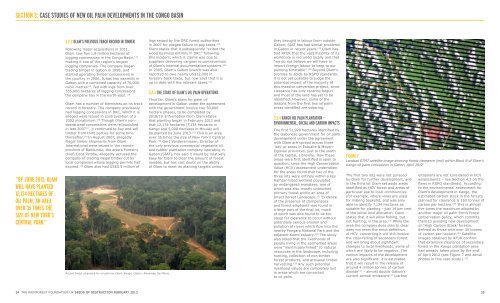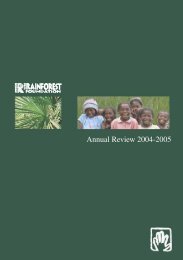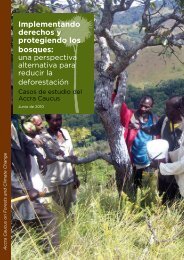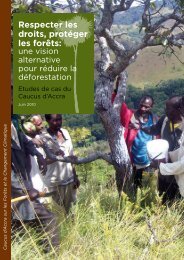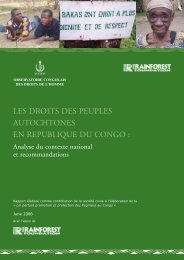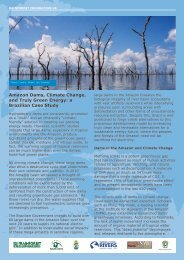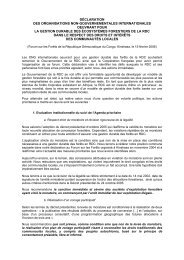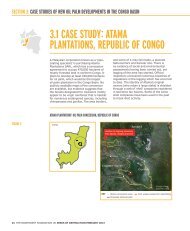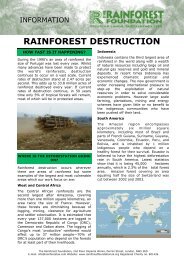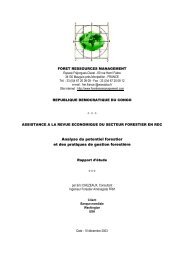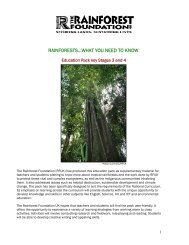Seeds of Destruction - Rainforest Foundation UK
Seeds of Destruction - Rainforest Foundation UK
Seeds of Destruction - Rainforest Foundation UK
You also want an ePaper? Increase the reach of your titles
YUMPU automatically turns print PDFs into web optimized ePapers that Google loves.
SECTION 3: CASE STUDIES OF NEW OIL PALM DEVELOPMENTS IN THE CONGO BASIN<br />
“By June 2013, Olam<br />
will have planted<br />
12,134 hectares <strong>of</strong><br />
oil palm, an area<br />
over 35 times the<br />
size <strong>of</strong> New York’s<br />
Central Park.”<br />
3.2.2 OLAM’S PREVIOUS TRACK RECORD IN TIMBER<br />
Following major acquisitions in 2011,<br />
Olam now has 1.8 million hectares <strong>of</strong><br />
logging concessions in the Congo Basin, 113<br />
making it one <strong>of</strong> the region’s largest<br />
logging companies. The company began<br />
trading timber in Gabon in 1998, and<br />
started operating timber concessions in<br />
the country in 2006. It has two sawmills in<br />
Gabon with a combined capacity <strong>of</strong> 70,000<br />
cubic metres 114 , fed with logs from over<br />
555,000 hectares <strong>of</strong> logging concessions<br />
the company has in the north-east. 115<br />
Olam has a number <strong>of</strong> blemishes on its track<br />
record in forestry. The company previously<br />
had logging concessions in DRC, which it is<br />
alleged were issued in contravention <strong>of</strong> a<br />
2002 moratorium. 116 Though Olam’s nonoperational<br />
concessions were relinquished<br />
in late 2007 117 , it continued to buy and sell<br />
timber from third parties for some time<br />
thereafter. 118 In August 2007, allegedly<br />
illegal timber shipments from Olam<br />
International were seized in the remote<br />
province <strong>of</strong> Bandundu; the area’s Forestry<br />
chief, Coco Pembe, allegedly accused the<br />
company <strong>of</strong> trading illegal timber cut by<br />
local companies whose logging permits had<br />
expired. 119 Olam also had US$0.5 million <strong>of</strong><br />
Recent forest clearance for oil palm by Olam, Kango, Gabon. Alexander De Marcq<br />
logs seized by the DRC forest authorities<br />
in 2007 for alleged failure to pay taxes. 120<br />
Olam states that it subsequently “exited the<br />
wood business entirely in DRC” following<br />
this incident, which it claims was due to<br />
suppliers delivering cargoes in contravention<br />
<strong>of</strong> Olam’s internal documentation systems. 121<br />
In 2005, Olam’s Gabon branch was also<br />
reported to owe nearly US$12,000 in<br />
forestry back-taxes, but now says that it is<br />
up to date with the relevant taxes. 122<br />
3.2.3 THE START OF OLAM’S OIL PALM OPERATIONS<br />
Thus far, Olam’s plans for palm oil<br />
development in Gabon under the agreement<br />
with the government involve two 50,000<br />
hectare phases, to be completed by<br />
2018/19. Information from Olam states<br />
that planting began in February 2012 and<br />
that 12,134 hectares (7,134 hectares in<br />
Kango and 5,000 hectares in Mouila) will<br />
be planted by June 2013. 123 This is an area<br />
over 35 times the size <strong>of</strong> New York’s Central<br />
Park. 124 Gert Vandersmissen, Director <strong>of</strong><br />
the only previous commercial vegetable oil<br />
and rubber plantation company operating in<br />
Gabon (SIAT), has said it would be relatively<br />
easy for Olam to clear the amount <strong>of</strong> forest<br />
needed, but has cast doubt on the ability<br />
<strong>of</strong> Olam to meet its planting targets unless<br />
they brought in labour from outside<br />
Gabon; SIAT has had similar problems<br />
in Gabon in recent years. 125 Olam has<br />
told RF<strong>UK</strong> that the vast majority <strong>of</strong> its<br />
workforce is recruited locally and that<br />
“we do not believe we will have to<br />
import foreign labour to keep to our<br />
planting timetable”. 126 Beyond Olam’s<br />
promise to abide by RSPO standards,<br />
it is not yet possible to judge the<br />
potential impact <strong>of</strong> the majority <strong>of</strong><br />
this massive conversion project, since<br />
clearance has only recently begun<br />
and most <strong>of</strong> the land has yet to be<br />
identified. However, some <strong>of</strong> the<br />
lessons from the first two oil palm<br />
areas identified are sobering.<br />
3.2.4 KANGO OIL PALM PLANTATION –<br />
ENVIRONMENTAL, SOCIAL AND CARBON IMPACTS<br />
The first 51,920 hectares identified by<br />
the Gabonese government for oil palm<br />
development under the agreement<br />
with Olam are spread across three<br />
‘lots’ or areas in Estuaire & Moyen-<br />
Ogooue provinces, just to the south<br />
<strong>of</strong> the capital, Libreville. How these<br />
areas were first identified is open to<br />
question, since the High Conservation<br />
Value (HCV) assessment undertaken<br />
for the areas found that two <strong>of</strong> the<br />
three lots were entirely within a key<br />
Ramsar-listed wetland populated<br />
by endangered manatees, one <strong>of</strong><br />
which was also mostly untouched<br />
primary forest within an area <strong>of</strong><br />
Intact Forest Landscape. 127 Evidence<br />
<strong>of</strong> the presence <strong>of</strong> chimpanzees<br />
and forest elephants was found in<br />
a large part <strong>of</strong> the final lot, much<br />
<strong>of</strong> which was also found to be too<br />
steep for clearance to occur without<br />
potentially serious erosion and<br />
pollution <strong>of</strong> rivers which flow into the<br />
nearby Pongara National Park and the<br />
adjacent Komo estuary. 128 The study<br />
also noted that the livelihoods <strong>of</strong><br />
people living in the earmarked areas<br />
were “inextricably linked” to natural<br />
resources in the landscape, including<br />
hunting, collection <strong>of</strong> non-timber<br />
forest products, and artisanal timber<br />
harvesting. 129 Any such potential<br />
livelihood values are completely lost<br />
in areas which are converted<br />
to oil palm.<br />
FIGURE 7<br />
Landsat ETM7 satellite image showing forest clearance (red) within Block 8 <strong>of</strong> Olam’s<br />
Kango oil palm concession in Gabon, April 2012’<br />
The first two lots were not pursued<br />
by Olam for further development, and<br />
in the third lot Olam set aside areas<br />
identified as HCV forest and areas <strong>of</strong><br />
particular use to local communities<br />
(for example, where vines are used<br />
for making baskets), and was only<br />
able to identify 7,134 hectares as<br />
suitable for planting - just 14 per cent<br />
<strong>of</strong> the initial land allocation. Olam<br />
states that it will allow fishing, but<br />
not hunting, in the area. 130 While the<br />
area the company does plan to clear<br />
does not meet the strict definition<br />
<strong>of</strong> HCV, converting it will still involve<br />
the clear-felling <strong>of</strong> secondary forest<br />
and will bring about significant<br />
changes to local livelihoods, some <strong>of</strong><br />
which are likely to be negative. The<br />
carbon impacts <strong>of</strong> the development<br />
are also significant: it is estimated<br />
that it will result in the release <strong>of</strong><br />
around 4 million tonnes <strong>of</strong> carbon<br />
dioxide 131 – almost double Gabon’s<br />
current annual emissions 132 (carbon<br />
emissions are not considered in HCV<br />
assessments – see Section 4.3 on the<br />
flaws in RSPO standards). According<br />
to the environmental assessment for<br />
Olam’s development in Kango, the<br />
estimated carbon stock in the forests<br />
planned for clearance is 160 tonnes <strong>of</strong><br />
carbon per hectare. 133 This is almost<br />
five times the maximum allowed by<br />
another major oil palm firm’s forest<br />
conservation policy, which commits<br />
them to avoiding new development<br />
on ‘High Carbon Stock’ forests,<br />
defined as those with over 35 tonnes<br />
<strong>of</strong> carbon per hectare. 134 Satellite<br />
images obtained by RF<strong>UK</strong> confirm<br />
that extensive clearance <strong>of</strong> secondary<br />
forest in the Kango plantation area<br />
had already taken place by the end<br />
<strong>of</strong> April 2012 (see Figure 7 and aerial<br />
photos in this case study.). 135<br />
34 THE RAINFOREST FOUNDATION <strong>UK</strong> SEEDS OF DESTRUCTION FEBRUARY 2013 35


